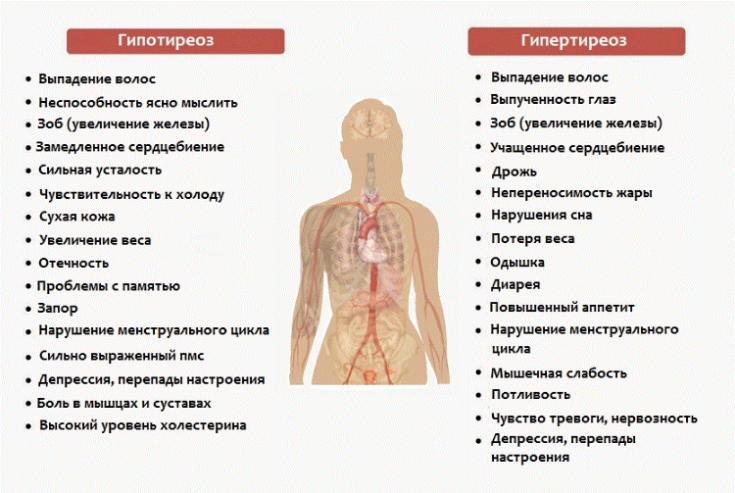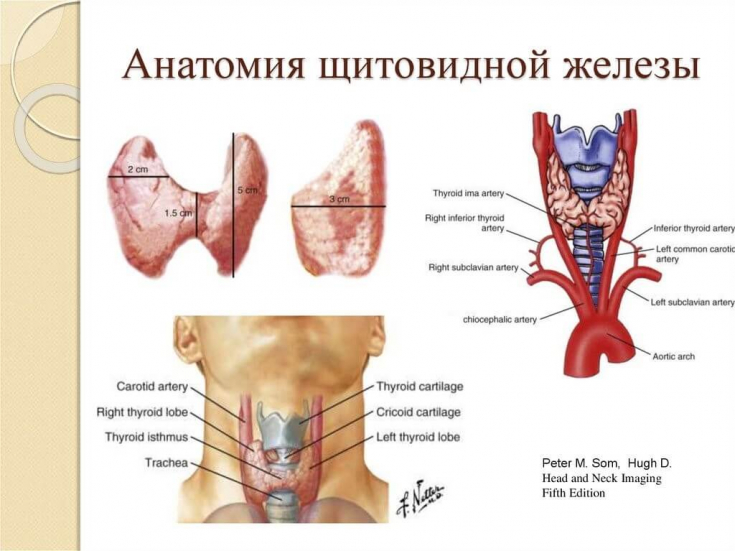If the thyroid disease is not accompanied by hormonal disorders, it may not cause suspicion in the patient for a long time. An increase in gland tissue in benign and malignant neoplasms leads to stretching of the capsule and the occurrence of pain syndrome.
Find out in the article on estet-portal.com which thyroid diseases most often lead to pain, and which pathology should be excluded in the diagnosis in the first place.
- Causes of pain in the thyroid gland
- Primary and secondary neoplasms of the thyroid gland
- Non-cancerous causes of enlarged thyroid glands
Causes of pain in the thyroid gland
The most common causes of volumetric processes of the thyroid gland are goiter and nodular forms of goiter, as well as acute and subacute thyroiditis at the initial stage.
Follow us on Instagram!
However, there are other causes of pain in the thyroid gland, including primary fast-growing or secondary metastatic tumors of the thyroid gland. Rapid enlargement of thyroid tissue causes painful stretching of the capsule. Very aggressive tumors quickly infiltrate the surrounding tissues, including the muscles of the neck, which also causes pain, as in subacute thyroiditis.
These tumors, like inflammation of the thyroid gland in subacute thyroiditis, also have a hard consistency.
Primary and secondary neoplasms of the thyroid gland
Fast-growing primary thyroid carcinomas are characterized by a rapid course of the disease, and untimely diagnosis, even for a week or two, can drastically reduce the duration and worsen the quality of life of patients. Thyroid metastases can also grow rapidly, stretching the capsule and infiltrating surrounding tissues, resulting in neck pain. Thyroid abscess is difficult to distinguish from subacute thyroiditis and should be remembered as a very rare condition.
Attention to the face: signs of possible thyrotoxicosis in the patient
All of the above causes of the development of pain syndrome with an increase in the thyroid gland are accompanied by a significant increase in the level of ESR as a result of the progression of oncological disease. A good response to corticosteroid treatment cannot be a marker for the presence of subacute thyroiditis, since improvement in symptoms is observed in most cases even with primary and secondary malignant thyroid tumors.

Cases presented in various publications clearly indicate that primary thyroid tumors with a poor prognosis, in particular anaplastic cancer, may be clinically similar to manifestations of subacute thyroiditis. Typical symptoms include neck pain radiating to the ear, mandible and/or chest and elevated ESR. Differentiated thyroid cancers progress much more slowly than anaplastic thyroid cancers, rarely infiltrate the surrounding tissues of the neck, and usually do not show a significant increase in ESR.
How does the skin react to a lack of thyroid hormones
According to the current literature, the most common malignant neoplasm that metastasizes to the thyroid gland is renal cell carcinoma (48.1%), colorectal cancer (10.4%), lung cancer (8.3%), carcinoma breast (7.8%) and sarcoma (4.0%). Some studies suggest that thyroid metastases are more common in women than in men. In most cases, the diagnosis of primary cancer is made many months before the detection of thyroid metastases.

In about 20% of cases, the diagnosis of the primary tumor and its metastasis to the thyroid gland is established simultaneously. In very rare cases, metastasis is the first symptom of advanced cancer. Thyroid − an extremely rare site of non-small cell lung cancer metastasis, as the brain, bones, liver, adrenal glands, contralateral lung, and distant lymph nodes are the most common. Other sites are defined as rare because they cover <5% of all metastases.
Neurological and psychiatric symptoms of hyperthyroidism
Non-cancer causes of thyroid enlargement
Symptoms of thyroid amyloidosis may be similar to those of subacute thyroiditis and also manifest as an enlarged thyroid gland, an accelerated ESR, a decrease in iodine storage capacity, and a good response to glucocorticoid treatment. It should always be remembered that the differential diagnosis of diseases that are suggestive of subacute thyroiditis must also include amyloidosis.
Hypothyroidism treatment: what you need to know about the features of the disease
Sometimes, primary and secondary malignant thyroid tumors masquerade as de Quervain's thyroiditis. Based on this experience and a review of the literature, the authors argue that thyroid ultrasonography should definitely be included in the main criteria for the diagnosis of subacute thyroiditis, together with TAPN.
How to deal with injectable treatment for hypothyroidism in women







Add a comment